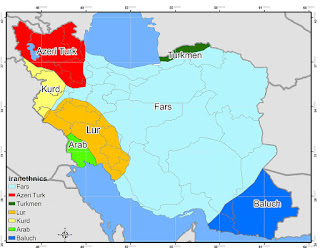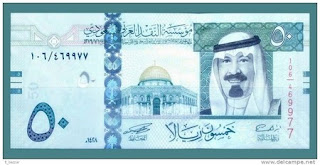Protest in Iran: The murky geopolitics of soccer
Source: Ahwaz Monitor
By James M. Dorsey
Thousands of Iranian Arabs last week attended
an AFC Champions League soccer match between Esteghlal Ahvaz FC and Qatar’s Lekhwiya
SC dressed in traditional Arab garb in
protest what an opposition news website dubbed were government efforts to
suppress their identity.
The English-language website, Ahwaz Monitor, said support for
Esteghlal turned into anti-government protests with fans cheering their team in
Arabic rather than Farsi. Fans chanted “national slogans” such as “Arabic is my
identity and honour” and “Al Ahwaz for Ahwazis and all Gulf state residents are
dearest to us.” Fans reportedly recited poetry celebrating their region’s Arab
heritage.
Al Ahwaz is the Arabic name for the oil-rich
but impoverished, south-eastern Iranian province of Khuzestan that borders on
Iraq and sits at the head of the Gulf. It is also the name of the province’s
capital that hosts Iran’s foremost refinery. Part of Khuzestan’s ethnic and religious
mosaic, ethnic Arabs are believed to account for at least one third of its 3.7
million inhabitants. Iranian Arabs put the figure much higher.
Ahwaz Monitor started operations last summer,
providing regular reports on Iranian Arabs and government efforts to suppress
their identity and deprive them of their rights. It’s not clear who funds or
owns the website.
Eruptions of genuine discontent in Khuzestan,
particularly on soccer pitches when Asian competition matches are played
against teams from the Gulf, have become a fixture in a province that for
decades has been an overt and covert battlefield in the struggle between Saudi
Arabia and Iran for regional hegemony.
Protests have focussed on identity,
environmental degradation, and social issues. Iranian politicians warned of a “national
threat” in February when riots
erupted in 11 cities in Khuzestan after they lost power during a severe
dust storm. The outages led to water shortages as water and wastewater
treatment plants were knocked offline. Demonstrators chanted "Death to
tyranny", "We, the people of Ahwaz, won't accept oppression" and
"Clean air is our right, Ahwaz is our city."
International human rights groups have long
accused Iran of discriminating against Iranian Arabs even though many are
Shiites rather than Sunni Muslims. Dozens
of protesters were reportedly killed during demonstrations in Ahwaz in 2011
that were inspired by the popular Arab revolts.
“Despite Khuzestan's natural resource wealth,
its ethnic Arab population, which is believed to constitute a majority in the
province, has long complained about the lack of socio-economic development in
the region. They also allege that the Iranian government has engaged in
systematic discrimination against them, particularly in the areas of
employment, housing, and civil and political rights,” Human
Rights Watch said at the time.
Habib Jaber Al-Ahvazi, a spokesman for the
Arab Struggle Movement for the Liberation of Ahwaz (ASMLA), a group that
demands independence for Ahvaz and is believed to be responsible for bomb
attacks in the city in 2005, 2006 and 2013, told online Arab nationalist Ahvaz.tv in 2015 that soccer protests were part of an “ongoing confrontation between demonstrators and the
forces of the Persian occupation.”
There is little doubt that discontent in
Khuzestan is widespread and that repeated spontaneous protests in stadiums as
well as on the streets of the province’s cities were genuine. Yet, determining
what events and reporting is purely local and what elements may be linked to
potential Saudi and Gulf attempts to destabilize Iran is difficult.
Equally, there is little doubt that Saudi
Arabia and other Gulf Arabs have a long history of encouraging Iranian Arab
opposition and troubling the minority’s relations with the government.
Iranian Arabs believe that the government
fears that they are susceptible to foreign Arab influence. That suspicion,
Iranian Arabs say, is rooted in Iraqi leader Saddam Hussein’s bloody eight-year
war against Iran that ended in 1988. Saddam falsely expected that Iranian Arabs
would welcome the opportunity to gain independence from Iran.
The Iranian Arab refusal to side with Saddam
failed, however, to earn Arabs in Ahwaz the credit they deserved. Government
suspicions have been fuelled by recent conversions to Sunni Islam of a number
of Iranian Arabs.
Distrust is further fuelled by the fact that
much opposition news in Khuzestan is generated by organizations associated with
the exiled People’s Mujahedin Organization of Iran or Mujahedin-e-Khalq, a
militant left-wing group that advocates the overthrow of Iran’s Islamic regime
and traces its roots to resistance against the shah who was toppled in the 1979
revolution.
The Mujahedin based themselves in Iraq during
the Saudi-backed Iraqi war against Iran. More recently the group appears to
enjoy increased support from the kingdom. In a clear demonstration of Saudi
support, former Saudi intelligence chief and envoy to Britain and the United
States, Prince
Turki al-Faisal, told a Mujahedeen rally in Paris last year that "your
legitimate struggle against the (Iranian) regime will achieve its goal, sooner
or later. I, too, want the fall of the regime.”
Prince Turki’s remarks fit a pattern of Arab
calls for independence of Khuzestan. Writing in 2012 in Asharq Al Awsat, a
Saudi newspaper, Amal Al-Hazzani, an academic who has since been dropped from
the paper’s roster after she wrote positively about Israel, asserted in an
op-ed entitled “The oppressed Arab district of al-Ahwaz“ that “the
al-Ahwaz district in Iran...is an Arab territory... Its Arab residents have
been facing continual repression ever since the Persian state assumed control
of the region in 1925... It is imperative that the Arabs take up the al-Ahwaz
cause, at least from the humanitarian perspective.”
The notion that external forces may be
exploiting discontent in Khuzestan has broader implications amid reports that President
Donald J. Trump could revert to a policy of regime change in Iran. Iran has in
the past accused the United States and Saudi Arabia as well as Israel and
Britain of supporting nationalist insurgents in the Iranian province of Sistan-Baluchistan.
The province borders on the Pakistani region
of Balochistan where nationalists and jihadists have targeted Chinese
investment that is key to China’s One Belt, One Road initiative. Some
analysts have suggested that US and Saudi support for dissidents in various
Iranian provinces may be designed to force Iran to weaken, if not withdraw,
support for the regime of Syrian president Bashar al-Assad.
Pakistani
General
Qamar Javed Bajwa, apparently concerned that potential efforts
to destabilize Iran could aggravate volatility in Balochistan, noted earlier
this month that “enhanced
Pakistan-Iran military-to-military cooperation will have a positive impact on
regional peace and stability.”
Dr. James M.
Dorsey is a senior fellow at the S. Rajaratnam School of International Studies,
co-director of the University of Würzburg’s Institute for Fan Culture, and the
author of The Turbulent World
of Middle East Soccer blog, a book with
the same title, Comparative Political Transitions
between Southeast Asia and the Middle East and North Africa,
co-authored with Dr. Teresita Cruz-Del Rosario and three forthcoming books, Shifting Sands,
Essays on Sports and Politics in the Middle East and North Africa as
well as Creating Frankenstein: The Saudi Export of Ultra-conservatism and China
and the Middle East: Venturing into the Maelstrom.





Comments
Post a Comment